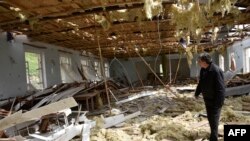Authorities in Nagorno-Karabakh are scrambling to resettle hundreds of local residents who fled their homes immediately after heavy fighting broke out along the Armenian-Azerbaijani “line of contact” around the territory on April 2.
Most of those people lived in the villages of Talish and Mataghis located in Karabakh’s northeastern tip, just a few kilometers from the heavily militarized frontline. Both settlements were entirely evacuated after being shelled and attacked by Azerbaijani troops at the start of the worst hostilities in the Karabakh conflict zone since 1994.
The Armenian-controlled villages remain virtually empty to this day as their displaced civilian residents are too scared to return home. The same is true for dozens of other Karabakh Armenian families who fled the nearby town of Martakert also close to “the line of contact.”
Talish, already ravaged during the 1991-1994 with Azerbaijan, was hit particularly hard by the fighting, with dozens of local houses destroyed or damaged by heavy shelling from Azerbaijani positions. Most of its 550 or so residents took refuge in Armenia.
More than 130 of them -- mainly children, women and elderly persons -- are now hosted by their relatives living in the central Armenian town of Charentsavan. The cash-strapped local authorities have only been able to pay 20,000 drams ($42) to each displaced family.
Ruzanna Sargsian, a 26-year-old woman, fled Talish with her newborn son, leaving behind her husband and brother who serve in the Karabakh army. “I hope they stay alive,” she said with tears in her eyes. “I want to again live in Karabakh, if not in the village, then in Stepanakert.”
With prospects for the conflict’s de-escalation still uncertain, Karabakh’s government is already trying to provide people like Ruzanna with temporary housing in other, safer Karabakh towns and villages. In recent days, a team of Karabakh Armenian officials visited Armenia and met with refugees for that purpose.
“We have opened temporary shelters in the [Karabakh] town of Shushi and offered our citizens to settle there,” Artur Aghabekian, Karabakh’s deputy prime minister, told RFE/RL’s Armenian service (Azatutyun.am) on Wednesday.
Most Talish refugees, at least in Charentsavan, are in no rush to relocate to other parts of Karabakh, however. “We will return to Talish as soon as it’s safe to live there,” one of them, Gayane Abrahamian, said. “We don’t intend to live in another village.”
Armen Hayrapetian, another villager, also told the visiting officials from Stepanakert that he and his family are only willing to return to Talish and rebuild their ruined house there. The 33-year-old man said his main concern is the safety of his young children.
Aghabekian admitted that it would be too dangerous for the displaced people to return to Talish or Mataghis now. But he said the Karabakh authorities are committed to their eventual repatriation.
“We could only save their lives,” said Aghabekian.“We have to do a lot more for them.”
“We will do everything to have our compatriots return to Artsakh (Karabakh),” added the Karabakh Armenian leader.






